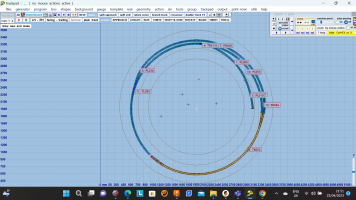I joined the passing loop to the turnouts by connecting short straight track to the turnout exit and then curving it so that it lines up with the passing loop. I then shorten the length of the straight track to meet the passing loop. It is OK but sleeper alignment is a bit crude..The loop was made using the double track. Is this the best way to do it?
@Michael Woods
Hi Michael,
Well yes, that sort of works, but manually it's tricky to get an accurate tangential alignment with the loop track.
There are several built-in methods to terminate a loop, with different pros and cons:
1. parallel V-crossing:
In this case the return curve is an integral part of the turnout template. That's simple and quick, the whole thing can be curved as required in one go, and you can easily extend or join the loop template to the turnout. The whole thing can be on a transition curve if required.
The loop track must be concentric/parallel with the main road. The big disadvantage is that this is all a single template, so you can't insert any pointwork in the return curve. Often, but not always, such a loop would be terminated in trap points, such as a set of catch points or a full turnout. In which case this method can't be used. The above dialog is at
template > V-crossing settings... menu item.
2. make return curve:
In this case the return curve is created as a separate plain track template. It can therefore have a turnout inserted in it if required. Start with the main turnout in the the control template and click the
return curve button. Again the loop track must be concentric/parallel with the main road. In this case it must be a constant curve or straight, this function doesn't work on transition curves.
3. make simple link:
In this case the loop track does not need to be concentric or parallel to the main road. For example it may curve around an island platform or some other structure. Start with the main turnout in the control template and click the
branch track button.
Now click on the
loop template, and click the above menu item.
You may have to answer some questions. The eventual result will be:
In this case the function will make the boundary join with the loop template automatically. Again the return curve is a separate template into which a turnout could be inserted.
More about
make simple link here:
https://85a.uk/templot/companion/make_simple_link.php
4. truncated slew:
This is a method for more experienced Templot users. The return curve is part of the loop track, which could therefore have a turnout inserted anywhere you like, there is no boundary to a separate return curve template. Using the
slew controls you can change the shape, radius and length of the return curve to whatever you want. The loop track can have a transition curve in it in addition to a slew if necessary. It's best to use a
mode 2 slew.
5. other methods:
There are several other ways that you might want to terminate a loop, perhaps using a transition curve. More info here:
https://85a.uk/templot/companion/make_transition_link.php
https://85a.uk/templot/companion/link_existing.php
Very often of course a loop terminates in a crossover, in which case the job is done for you very easily at
tools > make ordinary crossover menu item.
That's enough explaining and making screenshots for one day. I have been writing this stuff over and over again for more than 20 years now, and I'm finding it very tiring nowadays.
How about someone else explaining for Michael why the Brecon & Merthyr, absorbed into the GWR at the 1923 grouping, is very unlikely to have had any REA B-7 turnouts. The REA designs were introduced in 1925. There are 12ft and 15ft straight switches in the list which would do fine, or GWR switches for later renewals.
cheers,
Martin.
 Search
Search

